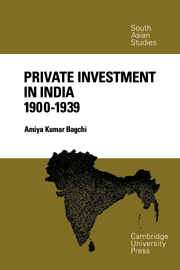Book contents
- Frontmatter
- Contents
- List of tables
- Preface
- Abbreviations
- PART I GENERAL – THEORETICAL FRAMEWORK
- PART II STUDIES OF MAJOR INDUSTRIES
- 7 The development of the cotton-mill industry
- 8 Private investment in the jute industry
- 9 The growth of the iron and steel industry
- 10 The growth of private engineering firms
- 11 The cement industry
- 12 The growth of the sugar industry
- 13 The development of the Indian paper industry
- 14 British imperial policy and the spread of modern industry in India
- Bibliography
- Index
7 - The development of the cotton-mill industry
from PART II - STUDIES OF MAJOR INDUSTRIES
Published online by Cambridge University Press: 06 January 2010
- Frontmatter
- Contents
- List of tables
- Preface
- Abbreviations
- PART I GENERAL – THEORETICAL FRAMEWORK
- PART II STUDIES OF MAJOR INDUSTRIES
- 7 The development of the cotton-mill industry
- 8 Private investment in the jute industry
- 9 The growth of the iron and steel industry
- 10 The growth of private engineering firms
- 11 The cement industry
- 12 The growth of the sugar industry
- 13 The development of the Indian paper industry
- 14 British imperial policy and the spread of modern industry in India
- Bibliography
- Index
Summary
HANDICRAFTS AND MILL PRODUCTION IN THE COTTON INDUSTRY
The textbook story of development of capitalist industry goes as follows: Given a blue-print of techniques, with a rise in wages a more capital-intensive technique than the one hitherto in use becomes profitable. Hence if a weaver was operating by hand only one loom it becomes profitable to add some device to speed up the production on the loom, thus increasing the amount of capital per weaver; the logical culmination becomes the displacement of the handloom by a powerloom. The speed of the change is not, however, dictated by the extent of rise in wages; it is determined by the rate of investment which in turn is dictated by the capitalists' share in income and their propensity to save.
One can adapt this story to the Indian case and argue that there occurred a rise in the standard of living of the Indian worker at the end of the nineteenth century; this was induced by the increase in the prosperity of the peasant through the greatly increased exports of primary products. The rise in the wages of workers combined with the removal of the barriers to free competition imposed by an inefficient transport system, to bring about a situation in which the powerloom became a more profitable implement than the handloom.
- Type
- Chapter
- Information
- Private Investment in India 1900–1939 , pp. 219 - 261Publisher: Cambridge University PressPrint publication year: 1972



